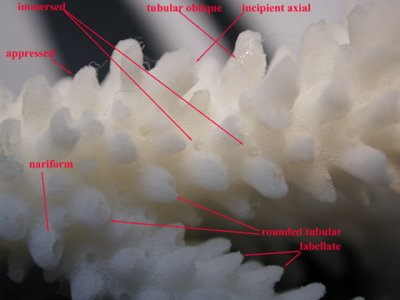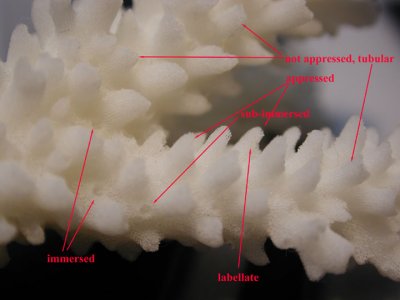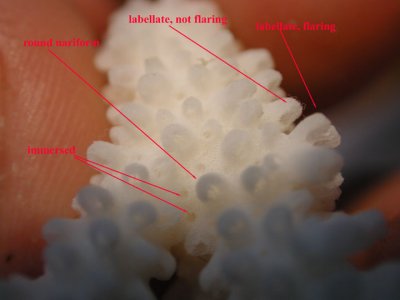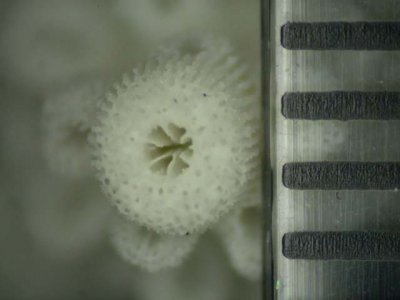Here is a list of terms:
tubular : tube-like
cochleariform : ear-like
nariform : nostril- or nose-like
labellate : lip-like (can be flaring or straight)
conical : the distal end tapers from a wider base
rounded tubular : berry- or keg-like
appressed : angled so that the inner edge lies against the corallum
sub-immersed : barely sticking out from the corallum with little ridges of wall showing
immersed : totally flat against the corallum
oblique : the opening appears as though a tube was cut at an angle
round: the opening is rounded when viewed from the end
oval : the opening is oval when viewed from the end
dimidiate : the wall forming the opening is incompletely developed
So, in a nutshell:
1. determine how many basic types of radial corallites exist on your colony
2. assess the angle - see if any gaps exist completely around the corallite, or if part of the corallite touches and remains connected with the rest of the corallum (appressed)
3. determine the opening shape
4. detemine the corallite shape
5. Measure the average corallite length, outer and inner diameter
6. Assess the septa as with the axials (how many, in how many cycles, and the degree as an approximate percentage of the radius with which they project into the opening).
Fortunately, we really don't have to address the variations along the septa as is required for many other corals. That makes is so much easier, doesn't it?
tubular : tube-like
cochleariform : ear-like
nariform : nostril- or nose-like
labellate : lip-like (can be flaring or straight)
conical : the distal end tapers from a wider base
rounded tubular : berry- or keg-like
appressed : angled so that the inner edge lies against the corallum
sub-immersed : barely sticking out from the corallum with little ridges of wall showing
immersed : totally flat against the corallum
oblique : the opening appears as though a tube was cut at an angle
round: the opening is rounded when viewed from the end
oval : the opening is oval when viewed from the end
dimidiate : the wall forming the opening is incompletely developed
So, in a nutshell:
1. determine how many basic types of radial corallites exist on your colony
2. assess the angle - see if any gaps exist completely around the corallite, or if part of the corallite touches and remains connected with the rest of the corallum (appressed)
3. determine the opening shape
4. detemine the corallite shape
5. Measure the average corallite length, outer and inner diameter
6. Assess the septa as with the axials (how many, in how many cycles, and the degree as an approximate percentage of the radius with which they project into the opening).
Fortunately, we really don't have to address the variations along the septa as is required for many other corals. That makes is so much easier, doesn't it?





